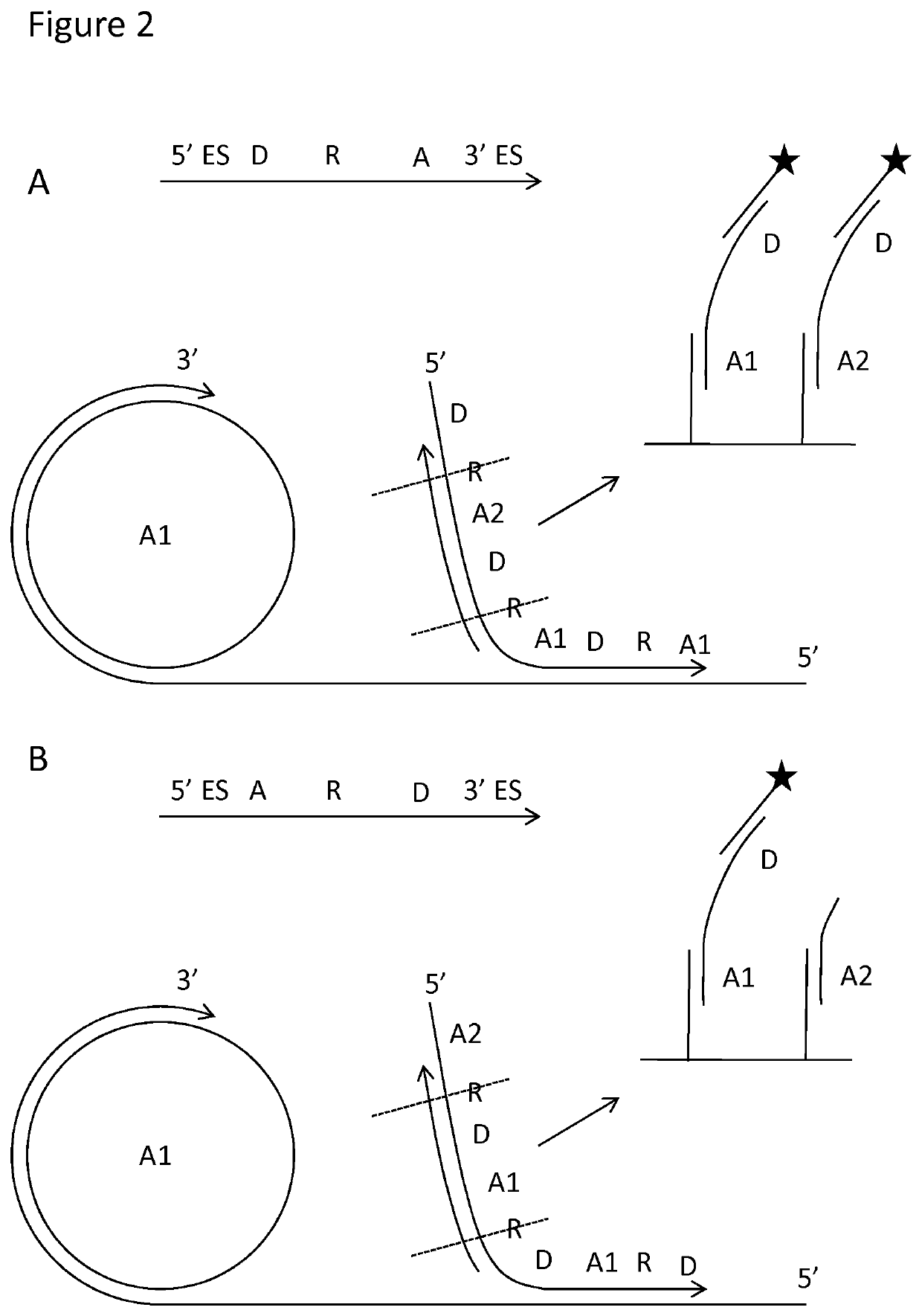Padlock probe detection method
- Summary
- Abstract
- Description
- Claims
- Application Information
AI Technical Summary
Benefits of technology
Problems solved by technology
Method used
Image
Examples
example 1
ate Dependent Signal Generated Using Padlock Probes
[0249]Non-template dependent signal in the assay was evaluated and compared to using a method as described in Göransson et al. 2012 PLoS One 7, e31068.
[0250]A multiplexed pool of 90 padlocks, complementary to different target nucleic acids in bacteria and yeast were used together with TE-buffer (10 mM Tris-HCl pH 7.5 1 mM EDTA); Dynabeads MyOne™ Streptavidin T1 beads (Invitrogen); a multiplexed pool of capture oligonucleotides complementary to a different part of the different target nucleic acids.
[0251]In each reaction, two positive control oligonucleotides are present: a linear padlock probe is added with a synthetic template as control for ligation and the RCA reaction; and a pre-formed circle as a control for the RCA reaction alone.
[0252]As no target nucleic acids are present in the sample no signal is expected, and any signal generated is background noise caused by non-specific between a padlock probes and another nucleic acid ...
example 2
etection
[0260]Signal to noise was evaluated and compared to using a method as described in Göransson et al. 2012 PLoS One 7, e31068.
[0261]The experiment was conducted as above, with 1250 copies of genomic E. coli DNA added to the positive reactions. Negative controls were performed as outlined above. The signal generated for each positive and negative reaction, and signal-to-noise values, are shown in FIG. 4.
[0262]The data show that the signal generated in the positive control samples using method of the present invention is equivalent to that of the prior art method, but that the signal generated in the negative control samples was lower (i.e. a reduced background) using the new method of the present invention.
[0263]It is noted that the negative control in the first experiment performed using the method of prior art had an unexpectedly high level of background signal. This indicates one of the effects the present method solves, i.e. unexpected high background in reactions.
example 3
RO / DO Sequence
[0264]Padlock probes with a separate array oligonucleotide sequence and a combined detection and restriction oligonucleotide sequence were used in the method as described above. In total, 90 padlock probes were used in the pool of padlock probes.
[0265]A sample spiked with genomic DNA preparations of four bacterial agents, one of which also contained the sequence for resistance gene mecA was analyzed at 2500, 500 or 100 genomic copies input amount, and the signal was compared to signal obtained in a negative control.
[0266]Signal-to-noise for each reaction was measured, and is shown in FIG. 5. A signal to noise between 10-100 was achieved at 100 genomic copies.
[0267]The background signal, reported as Relative Fluorescence Units (RFU) in the negative controls for the five padlock probes sets reported were 47. The average background signal for the remaining padlock probes in the reaction was 27 measured as RFU in all reactions, including were DNA were spiked in for the fiv...
PUM
 Login to View More
Login to View More Abstract
Description
Claims
Application Information
 Login to View More
Login to View More - R&D
- Intellectual Property
- Life Sciences
- Materials
- Tech Scout
- Unparalleled Data Quality
- Higher Quality Content
- 60% Fewer Hallucinations
Browse by: Latest US Patents, China's latest patents, Technical Efficacy Thesaurus, Application Domain, Technology Topic, Popular Technical Reports.
© 2025 PatSnap. All rights reserved.Legal|Privacy policy|Modern Slavery Act Transparency Statement|Sitemap|About US| Contact US: help@patsnap.com



